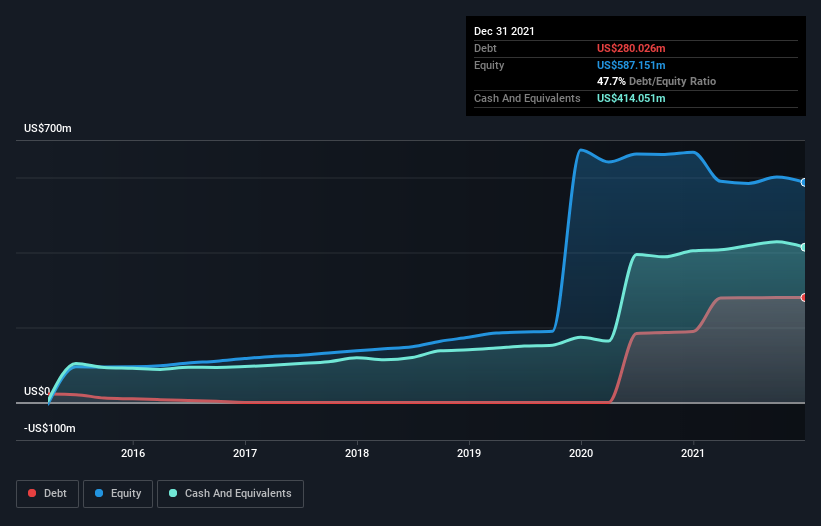
Legendary fund manager Li Lu (who Charlie Munger backed) once said, 'The biggest investment risk is not the volatility of prices, but whether you will suffer a permanent loss of capital.' So it might be obvious that you need to consider debt, when you think about how risky any given stock is, because too much debt can sink a company. We can see that Glaukos Corporation (NYSE:GKOS) does use debt in its business. But the more important question is: how much risk is that debt creating?
When Is Debt A Problem?
Debt assists a business until the business has trouble paying it off, either with new capital or with free cash flow. In the worst case scenario, a company can go bankrupt if it cannot pay its creditors. However, a more common (but still painful) scenario is that it has to raise new equity capital at a low price, thus permanently diluting shareholders. By replacing dilution, though, debt can be an extremely good tool for businesses that need capital to invest in growth at high rates of return. When we examine debt levels, we first consider both cash and debt levels, together.
View our latest analysis for Glaukos
What Is Glaukos's Debt?
You can click the graphic below for the historical numbers, but it shows that as of December 2021 Glaukos had US$280.0m of debt, an increase on US$189.4m, over one year. But it also has US$414.1m in cash to offset that, meaning it has US$134.0m net cash.

How Strong Is Glaukos' Balance Sheet?
According to the last reported balance sheet, Glaukos had liabilities of US$63.4m due within 12 months, and liabilities of US$399.2m due beyond 12 months. On the other hand, it had cash of US$414.1m and US$33.4m worth of receivables due within a year. So its liabilities outweigh the sum of its cash and (near-term) receivables by US$15.1m.
This state of affairs indicates that Glaukos' balance sheet looks quite solid, as its total liabilities are just about equal to its liquid assets. So while it's hard to imagine that the US$2.38b company is struggling for cash, we still think it's worth monitoring its balance sheet. Despite its noteworthy liabilities, Glaukos boasts net cash, so it's fair to say it does not have a heavy debt load! When analysing debt levels, the balance sheet is the obvious place to start. But it is future earnings, more than anything, that will determine Glaukos's ability to maintain a healthy balance sheet going forward. So if you're focused on the future you can check out this free report showing analyst profit forecasts.
Over 12 months, Glaukos reported revenue of US$294m, which is a gain of 31%, although it did not report any earnings before interest and tax. With any luck the company will be able to grow its way to profitability.
So How Risky Is Glaukos?
Statistically speaking companies that lose money are riskier than those that make money. And in the last year Glaukos had an earnings before interest and tax (EBIT) loss, truth be told. Indeed, in that time it burnt through US$23m of cash and made a loss of US$50m. But the saving grace is the US$134.0m on the balance sheet. That means it could keep spending at its current rate for more than two years. With very solid revenue growth in the last year, Glaukos may be on a path to profitability. Pre-profit companies are often risky, but they can also offer great rewards. There's no doubt that we learn most about debt from the balance sheet. But ultimately, every company can contain risks that exist outside of the balance sheet. For instance, we've identified 2 warning signs for Glaukos that you should be aware of.
If you're interested in investing in businesses that can grow profits without the burden of debt, then check out this free list of growing businesses that have net cash on the balance sheet.
New: Manage All Your Stock Portfolios in One Place
We've created the ultimate portfolio companion for stock investors, and it's free.
• Connect an unlimited number of Portfolios and see your total in one currency
• Be alerted to new Warning Signs or Risks via email or mobile
• Track the Fair Value of your stocks
Have feedback on this article? Concerned about the content? Get in touch with us directly. Alternatively, email editorial-team (at) simplywallst.com.
This article by Simply Wall St is general in nature. We provide commentary based on historical data and analyst forecasts only using an unbiased methodology and our articles are not intended to be financial advice. It does not constitute a recommendation to buy or sell any stock, and does not take account of your objectives, or your financial situation. We aim to bring you long-term focused analysis driven by fundamental data. Note that our analysis may not factor in the latest price-sensitive company announcements or qualitative material. Simply Wall St has no position in any stocks mentioned.
About NYSE:GKOS
Glaukos
An ophthalmic pharmaceutical and medical technology company, focuses on the development of novel therapies for the treatment of glaucoma, corneal disorders, and retinal diseases.
Adequate balance sheet and slightly overvalued.

